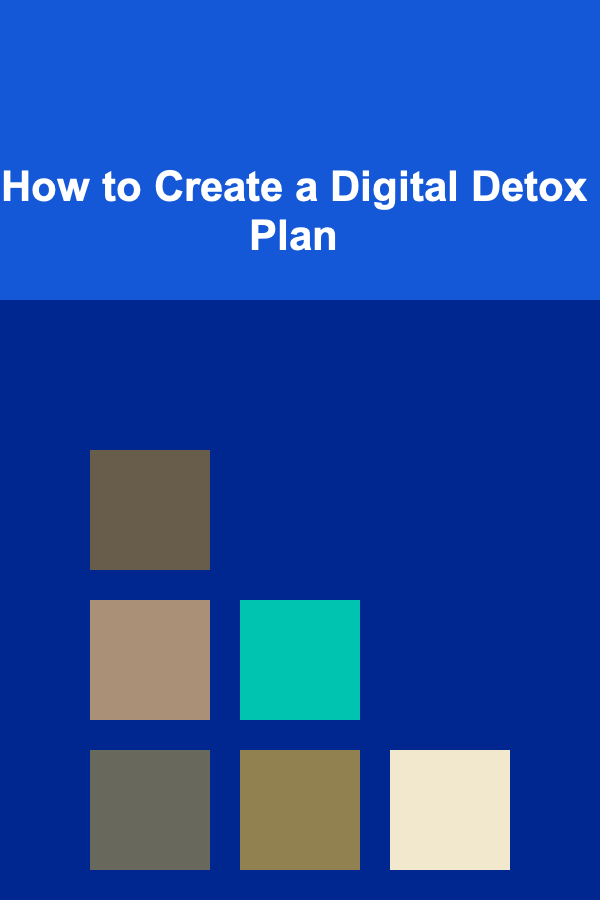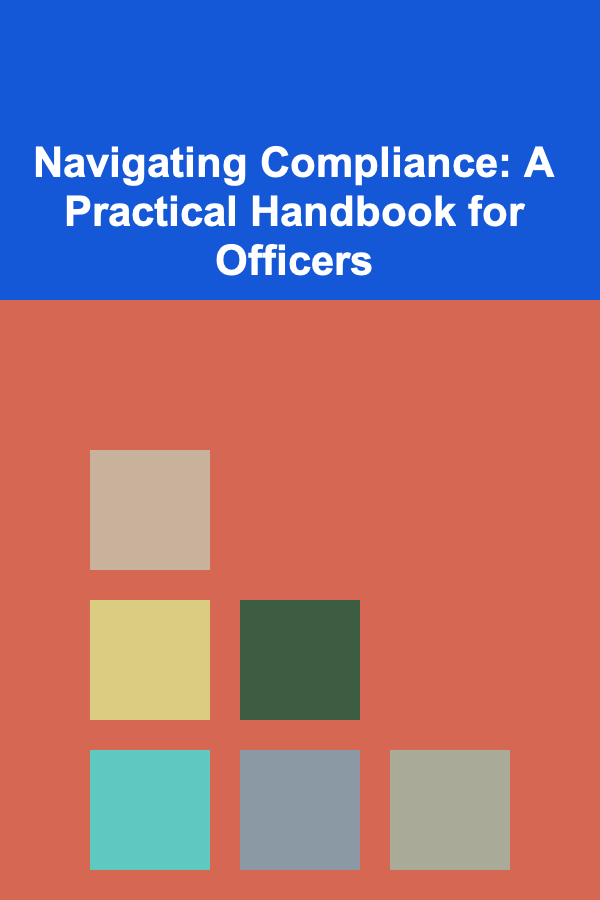
How to Create a Digital Detox Plan
ebook include PDF & Audio bundle (Micro Guide)
$12.99$6.99
Limited Time Offer! Order within the next:

In today's fast-paced, hyper-connected world, it's increasingly difficult to escape the constant pull of digital devices. From the moment we wake up to the second we fall asleep, screens are ever-present in our lives, whether through smartphones, computers, or televisions. While technology has undoubtedly brought about numerous conveniences and efficiencies, it also has a darker side, leading to burnout, stress, and a decline in mental well-being.
A digital detox is a period of time during which an individual refrains from using digital devices. It's a much-needed pause that allows you to disconnect from the digital world, regain your focus, and reconnect with the real world. In this article, we'll explore the importance of digital detox, the benefits it offers, and how to create a personalized digital detox plan that works for you.
Why Do You Need a Digital Detox?
The Impact of Excessive Screen Time
Excessive screen time can have profound effects on both physical and mental health. Some of the most significant impacts include:
- Mental Health Decline: Constant engagement with social media and digital platforms can lead to feelings of anxiety, depression, and loneliness. Studies have shown that people who spend more time on social media are more likely to experience negative emotions such as inadequacy, jealousy, and fear of missing out (FOMO).
- Decreased Productivity: While digital tools are meant to improve efficiency, too much time spent online can lead to distractions and a decrease in productivity. Constant notifications, emails, and messages can fragment your focus and reduce your ability to complete tasks effectively.
- Sleep Disruptions: The blue light emitted by digital screens interferes with the production of melatonin, the hormone responsible for regulating sleep. As a result, excessive screen time, especially before bed, can lead to poor sleep quality and insomnia.
- Physical Health Issues: Extended screen time often leads to issues such as eye strain, neck pain, back problems, and poor posture. The term "tech neck" has become popular to describe the discomfort caused by long hours of looking down at screens.
The Psychological Toll
The constant stream of information and engagement online can contribute to mental overload. Our brains are not designed to handle the bombardment of notifications, news, emails, and social media updates all day long. As a result, stress and anxiety levels increase, leading to burnout. This constant need to be "plugged in" creates a sense of urgency and pressure, preventing individuals from fully relaxing or enjoying their time.
Benefits of a Digital Detox
A digital detox provides numerous benefits that can improve your mental, emotional, and physical well-being:
- Reduced Stress and Anxiety: Disconnecting from technology allows you to step away from the pressures and stressors associated with constant digital engagement.
- Improved Focus: Without the constant distractions of digital notifications and alerts, you can focus more effectively on tasks at hand, whether that's working, reading, or spending time with loved ones.
- Better Sleep: Taking a break from screens, especially before bedtime, can improve sleep quality and restore a healthier sleep cycle.
- Enhanced Creativity: When you remove yourself from the noise of the digital world, you create space for deeper thinking, creativity, and problem-solving.
- Physical Rejuvenation: By taking breaks from screens, you give your eyes and body a chance to recover from the physical strain caused by prolonged digital device usage.
Now that we've established why a digital detox is essential, let's explore how to create a plan that fits your lifestyle and needs.
Steps to Create Your Digital Detox Plan
1. Assess Your Current Digital Habits
Before you can begin your digital detox, it's important to understand how much time you currently spend online. Take a few days to track your screen time and the activities you engage in on your devices. You may find that you spend hours on social media, scrolling through news feeds, or replying to emails, without even realizing how much time is slipping away.
- Track Screen Time: Use screen time-tracking apps to monitor how much time you spend on your devices. Many smartphones have built-in features that allow you to track daily usage. Alternatively, third-party apps like RescueTime can provide detailed insights into your digital habits.
- Evaluate Your Digital Consumption: Identify which activities are most consuming your time. Are you spending too much time on social media? Are work-related emails constantly interrupting your day? Is your entertainment consumption (movies, games, etc.) excessive?
By gaining a clear understanding of your current habits, you can set realistic goals for your detox.
2. Set Specific Goals
A successful digital detox requires clear goals and intentions. Simply deciding to "take a break from screens" isn't enough to make a significant impact. Be specific about what you want to achieve.
- Time Limits: Set clear limits on how much time you'll spend online each day. For example, you might limit social media to 30 minutes per day or restrict email checking to once in the morning and once in the evening.
- Device Restrictions: Decide which devices you'll reduce or eliminate using during your detox. For example, you might decide to avoid using your smartphone after 8:00 PM or avoid checking emails during weekends.
- Detox Duration: Determine how long your digital detox will last. Some people choose to detox for a weekend, while others may commit to a week or more. Be realistic about how much time you can handle.
3. Prepare for the Detox
Successfully executing a digital detox requires preparation. Here are some steps to help you get ready:
- Inform Others: If you have work or family commitments that rely on your digital presence, inform others in advance. Let colleagues know that you'll be less available and provide alternative methods for reaching you in case of emergencies.
- Remove Distractions: Set up your environment to reduce digital temptations. This could mean turning off notifications, uninstalling distracting apps, or putting your devices in another room during designated detox periods.
- Create Offline Alternatives: Prepare alternatives to your usual digital activities. If you typically spend hours scrolling through social media, try substituting that time with reading a book, going for a walk, or engaging in a hobby that doesn't require a screen.
4. Gradually Reduce Screen Time
Instead of diving straight into a full-on digital detox, consider taking a gradual approach. This allows your mind and body to adjust without feeling overwhelmed.
- Start Small: Begin by eliminating one or two digital habits at a time. For example, you could start by refraining from using your phone for an hour each morning, then gradually extend this time each day.
- Designate Screen-Free Zones: Set specific areas of your home or office as screen-free zones. For instance, you might decide that your bedroom is a screen-free zone, helping to improve both sleep and relaxation.
5. Engage in Offline Activities
During your digital detox, replace your usual digital consumption with offline activities that foster relaxation and personal growth.
- Physical Activity: Engage in regular physical exercise, whether that's yoga, hiking, cycling, or going to the gym. Exercise helps to reduce stress, improve mood, and increase energy levels.
- Mindfulness and Meditation: Practicing mindfulness and meditation can help you reconnect with yourself and reduce the mental clutter caused by digital overload. Apps like Headspace or Calm can help guide you through the process.
- Social Interaction: Spend more time with friends, family, or colleagues in person. Engaging in meaningful, face-to-face conversations helps to foster connection and reduce feelings of loneliness or isolation that may result from excessive screen time.
6. Review and Adjust Your Plan
At the end of your digital detox, take time to reflect on the experience and evaluate how it affected you.
- Assess the Impact: Did you feel less stressed? Were you more productive or creative? Did you sleep better? Analyze the changes you experienced and note the benefits of taking a break from technology.
- Adjust for the Future: Based on your reflection, you can adjust your digital habits going forward. For example, you might decide to limit your social media usage to certain times of the day or set aside specific days of the week as tech-free days.
7. Maintain Healthy Digital Habits
Once your detox is complete, it's essential to implement strategies for maintaining a healthier relationship with technology. A digital detox isn't a one-time fix---it's an ongoing process of balance.
- Schedule Regular Breaks: Incorporate regular digital detox days or weekends into your routine. Designating time for digital detox periodically will help you maintain a healthy balance and avoid slipping back into old habits.
- Set Boundaries: Establish boundaries for when and how you use your devices. For instance, you might decide not to check emails or social media during family dinners or weekends.
- Practice Digital Minimalism: Focus on using technology only when necessary, and streamline your digital environment by decluttering apps, unsubscribing from irrelevant notifications, and minimizing unnecessary screen time.
Conclusion
In our increasingly digital world, taking time for a digital detox is more important than ever. By following the steps outlined in this article, you can create a personalized plan that helps you disconnect from technology, reduce stress, improve focus, and enhance overall well-being. Whether you opt for a weekend detox or a more extended break, the key is to set clear goals, gradually reduce your screen time, and replace digital habits with offline activities that nourish your mind and body.
A digital detox doesn't have to be an all-or-nothing endeavor---it's about finding balance. Reclaiming your time, improving your mental health, and fostering deeper, more meaningful connections in the real world are all possible when you prioritize your well-being over constant connectivity.

How to Advocate for Better Remote Work Practices
Read More
How to Master Home Design on a Low Budget
Read More
How to Monitor Your SEO Progress and Make Adjustments: A Comprehensive Guide
Read More
How to Organize Your Bathroom Without Overcrowding
Read More
How to Start an Antique Collection: A Beginner's Guide
Read More
Navigating Compliance: A Practical Handbook for Officers
Read MoreOther Products

How to Advocate for Better Remote Work Practices
Read More
How to Master Home Design on a Low Budget
Read More
How to Monitor Your SEO Progress and Make Adjustments: A Comprehensive Guide
Read More
How to Organize Your Bathroom Without Overcrowding
Read More
How to Start an Antique Collection: A Beginner's Guide
Read More